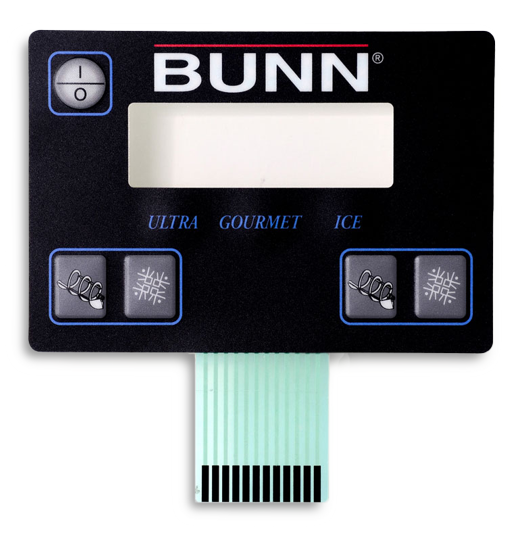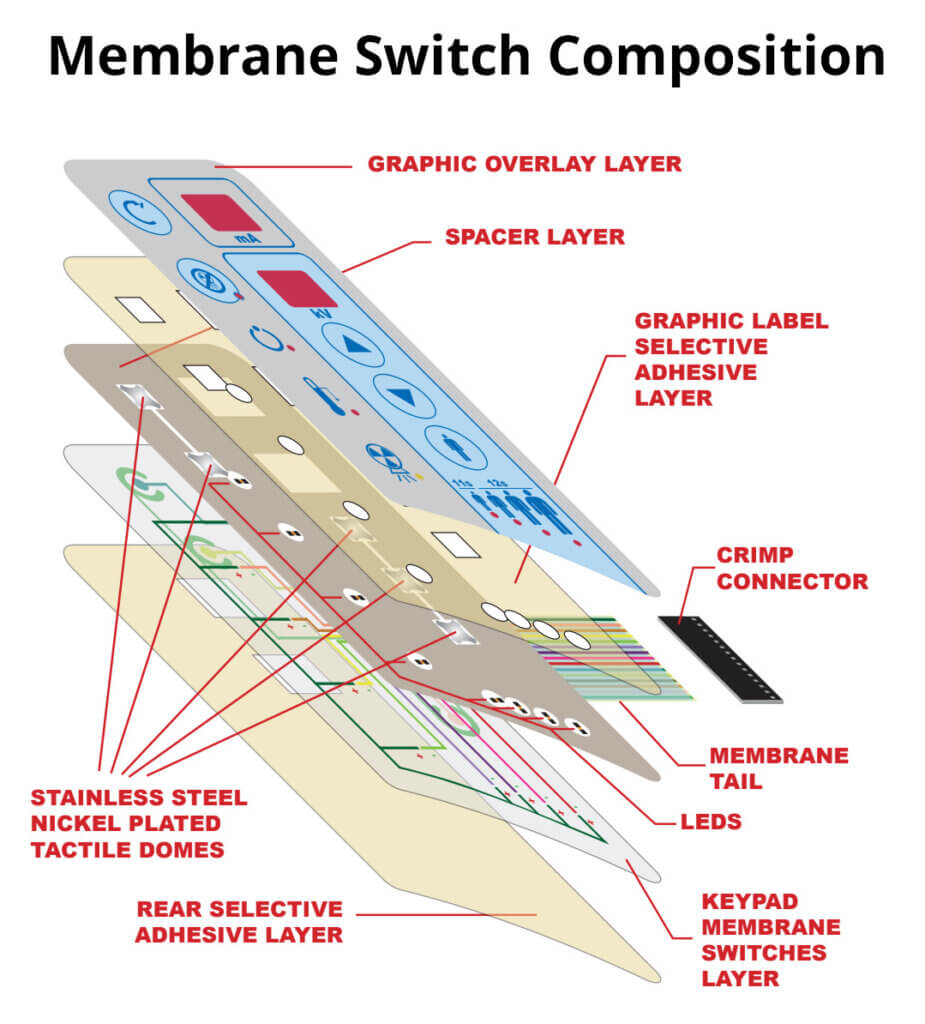See Why We’re a Preferred Membrane Switch Manufacturer
See Why We’re a Preferred Membrane Switch Manufacturer
Blog Article
Just How Membrane Switch Modern Technology Works and Its Function in Interface Design
Membrane switch modern technology is a sophisticated approach that incorporates layered materials for touch-sensitive input. Its layout contains graphic overlays, conductive layers, and sticky components that engage when pushed. This communication not only completes an electric circuit however likewise influences the general individual experience. Recognizing the intricacies of this technology reveals its significant influence on user interface style, provoking questions about its applications and future developments in various sectors.
Understanding Membrane Switch Innovation
Membrane switch innovation works as an essential component in modern-day customer interface layout. This technology combines graphic overlays, touch-sensitive membrane layers, and circuit layers to create a small, reputable input approach for various tools. The layout commonly includes several layers, consisting of a printed visuals layer that permits customers to engage with the tool via tactile feedback. Membrane buttons are known for their longevity, resistance to dampness, and convenience of cleaning, making them appropriate for environments where traditional mechanical switches might fail. Their low-profile layout enables smooth assimilation right into devices, adding to a streamlined appearance. In enhancement, Membrane switches can be tailored with different colors, structures, and signs, boosting user experience and visual allure. This versatility makes them preferred in consumer electronics, medical devices, and industrial controls, where user-friendly interaction is crucial. In general, Membrane switch modern technology stands for a considerable advancement in exactly how individuals involve with electronic interfaces.
Secret Elements of Membrane Switches
Membrane switches over include numerous essential components that add to their capability and style. The conductive layer materials, adhesive and assistance layers, and graphic overlay style each play a crucial role in guaranteeing excellent efficiency and customer communication. Comprehending these parts is crucial for efficient individual interface design.
Conductive Layer Materials
Conductive layer products play an essential function in the capability and dependability of Membrane buttons. When pressure is used to the switch, these materials are responsible for finishing electrical circuits. Generally, a mix of conductive inks, such as silver or carbon, is utilized to produce these layers. Silver conductive ink is preferred for its premium conductivity and sturdiness, while carbon ink is commonly used for economical applications. The choice of product influences not just the electrical performance however additionally the overall lifespan of the button. Additionally, the density and make-up of conductive layers can affect responsive comments and button actuation. Selecting the ideal conductive material is crucial for ensuring perfect performance in varied interface applications.
Adhesive and Assistance Layers
Sticky and support layers are important components that add to the architectural stability and performance of Membrane buttons. These layers give a durable foundation, ensuring that the different aspects of the Membrane button stay securely bound and correctly straightened throughout their functional life. The adhesive layer assists in the add-on of the switch to the underlying surface area, using sturdiness against ecological aspects such as dampness, temperature variants, and mechanical stress and anxiety. At the same time, support layers boost the switch's strength, protecting against deformation throughout use and adding to a constant tactile feedback. Together, these elements play a crucial role in preserving the efficiency and longevity of Membrane switches, inevitably affecting the overall individual experience in interface design.
Graphic Overlay Layout
Although commonly neglected, visuals overlay design plays a necessary role in the performance and looks of Membrane switches. This style mostly acts as the user interface in between the user and the electronics, offering both visual appeal and operational clarity. Efficient graphic overlays use color, typography, and symbols to guide users in understanding and maneuvering controls device functions. Furthermore, the choice of materials impacts resilience and tactile feedback, making certain the overlay withstands wear while maintaining a positive customer experience. Furthermore, specific alignment of the overlay with the underlying parts is essential for suitable performance. To conclude, thoughtful visuals overlay style boosts functionality, adds to brand identity, and eventually influences customer fulfillment in devices making use of Membrane button innovation.
The Production Process of Membrane Switches Over
The production process of Membrane changes involves numerous important actions that ensure functionality and longevity. A visuals overlay is developed, integrating customer interface aspects and branding. This overlay is printed onto an adaptable substrate, normally polyester or polycarbonate, making use of precision printing methods to determine quality and shade accuracy.Next, sticky layers are used, complied with by the integration of conductive traces, commonly made from silver or carbon, which are essential for electrical connectivity. These traces are screen-printed or etched onto a different layer. Hereafter, a spacer layer is included in create the needed void in between the overlay and the circuit layer, enabling responsive feedback when activated.Finally, the parts are put together and checked for top quality assurance, guaranteeing that each Membrane switch fulfills the called for specifications for performance and reliability. This thorough process results in a robust product fit for numerous applications in user interface design.
Advantages of Using Membrane Changes

Membrane switches over deal countless benefits that make them a favored option in user interface layout. One substantial advantage is their compact and light-weight nature, enabling structured styles in various applications. Additionally, Membrane switches offer a secured user interface, securing against dirt, moisture, and impurities, which boosts longevity and reliability. They are likewise very customizable, making it possible for designers to create unique graphics and formats tailored to details user needs.Another benefit is their cost-effectiveness, as they commonly need much less material and labor compared to typical switches. The responsive comments of Membrane buttons can be engineered to boost user experience, using a rewarding response without the mass of mechanical parts. Additionally, Membrane buttons can be quickly integrated into diverse environments, such as medical tools, industrial devices, and customer electronics. In general, these benefits emphasize the growing appeal of Membrane switches in contemporary customer interface layout.
Applications in Numerous Industries
Commonly used throughout numerous sectors, Membrane button technology has found its location in applications varying from clinical tools to customer electronics. In the healthcare market, these buttons are essential to devices such as analysis devices and individual surveillance systems, offering resilient, easy-to-clean interfaces that stand up to sanitation procedures. The vehicle industry uses Membrane buttons in see this site control panels and control board, giving trustworthy procedure in difficult environments.Consumer electronic devices, including home devices and pc gaming consoles, advantage from the streamlined style and customizability of Membrane buttons, enhancing user communication. In addition, commercial machinery uses these switches for control board, making sure resistance to dust and dampness while keeping functionality.Moreover, the aerospace and armed forces industries utilize Membrane buttons for tough applications, where dependability and performance are essential. On the whole, Membrane button innovation offers varied industries by integrating functionality, durability, and visual charm, making it a versatile selection for modern-day individual interfaces.

Designing Interface With Membrane Changes
When creating individual interfaces with Membrane buttons, cautious consideration of both performance and looks is essential. Membrane changes provide a sleek, inconspicuous design that can improve aesthetic charm while maintaining usability. Designers must concentrate on switch format, making certain user-friendly positioning for simplicity of operation. The responsive feedback supplied by the Membrane switch is vital; it can affect user fulfillment and total experience.Additionally, shade and graphic elements must align with the brand name identification, enhancing recognition and experience. Picking sturdy materials that stand up to wear and tear is likewise important, as durability adds to use in time. Incorporating backlighting can enhance presence in numerous lighting conditions, even more enhancing individual communication. Inevitably, a properly designed Membrane switch user interface equilibriums both kind and function, ensuring that the individual experience is both interesting and efficient, meeting the demands of diverse applications across markets.
Future Fads in Membrane Switch Modern Technology
As Membrane switch innovation progresses, the assimilation of smart functionalities is ending up being progressively famous. These improvements allow enhanced interactivity and connectivity within interface (membrane switch manufacturer). Additionally, the change in the direction of eco-friendly materials shows a growing dedication to sustainability in layout techniques
Smart Membrane Switches Over

Eco-Friendly Materials Usage
Among the developments in Membrane button innovation, a substantial trend is arising in the direction of making use of environmentally friendly products. Makers are increasingly focusing on sustainability by incorporating eco-friendly plastics and non-toxic inks, decreasing ecological impact. This shift not just aligns with worldwide ecological criteria yet likewise addresses customer need for greener items. Developments in product scientific research have allowed the growth of sturdy, environmentally friendly options that preserve efficiency without endangering quality. These materials offer comparable functionality to conventional choices while reducing waste and poisoning. As markets end up being a lot more eco-conscious, the combination of sustainable techniques in Membrane button manufacturing is expected to increase, reinforcing a dedication to environmental duty and leading the way for more lasting customer interface options in the future.
Often Asked Concerns
How Do Membrane Changes Differ From Typical Mechanical Switches?
Membrane switches vary from conventional mechanical buttons mainly in building and construction and operation. They utilize adaptable layers that produce a secured interface, whereas mechanical switches count on physical movement and contact, causing unique durability and tactile responses characteristics.
Can Membrane Changes Be Personalized for Particular Applications?
Membrane buttons can undoubtedly be customized for particular applications - membrane switch manufacturer. Suppliers develop them to satisfy one-of-a-kind demands, permitting tailored designs, graphics, and performances that boost customer interaction and fit particular operational requirements properly
What Is the Lifespan of a Membrane Switch?
The life expectancy of a membrane layer button typically ranges from 1 to 5 read the full info here million actuations, depending upon elements such as worldly top quality, ecological conditions, and usage regularity. Routine testing can help establish its durability and integrity in applications.
Are Membrane Switches Water Resistant or Immune to Chemicals?
Membrane buttons can be designed to be water-proof and resistant to chemicals, depending on the materials made use of and producing processes. Correct securing and protective finishings improve their toughness in numerous ecological conditions and applications.
Exactly How Do Membrane Switches Over Influence Tool Power Intake?
Membrane switches can greatly influence device power usage by guaranteeing efficient procedure. Their low power demands during activation help minimize power usage, adding to longer battery life and total enhanced effectiveness in electronic tools. Membrane buttons are understood for their resilience, resistance to dampness, and simplicity of cleaning, making them ideal for atmospheres where traditional mechanical switches might fail. The auto market uses Membrane buttons in control panels additional reading and control panels, supplying dependable procedure in challenging environments.Consumer electronic devices, including home devices and video gaming consoles, advantage from the sleek layout and customizability of Membrane switches, improving customer interaction. Furthermore, commercial machinery utilizes these buttons for control panels, guaranteeing resistance to dirt and moisture while preserving functionality.Moreover, the aerospace and army sectors use Membrane switches for tough applications, where integrity and efficiency are vital. The advancement of Membrane switch modern technology is entering an interesting stage with the appearance of smart Membrane buttons, which integrate sophisticated features and performances. Membrane switches over differ from typical mechanical buttons primarily in building and procedure.
Report this page